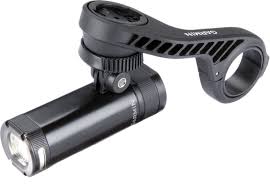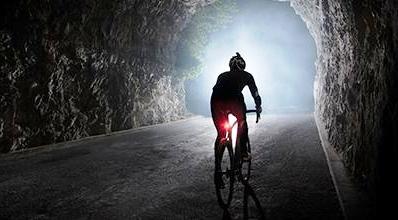Garmin UT800 Smart Headlight Review
I started writing my review of the Garmin UT800 smart headlight as part of a review of the second generation Varia RTL510 rear radar system – one of my favorite cycling accessories of recent years. As I got deeper into it, I realized that while the UT800 is a great companion to the RTL510. It is its own product. It deserves its own review!
While this is not a “deep dive” review, we’ll focus on the primary features of the UT800 that most people will find of interest.
What is the Garmin UT800?
 The UT800 is a front mounted light that can be used as a safety light for daytime riding or be used for night riding. It has a polished and modern aluminum body and small and light (~135 grams). The unit can be used as a standalone light or be included as part of a “Light Network” with a Garmin head unit and other lights like the aforementioned Varia. The UT800 is a competitive standalone light that features strong and adjustable light performance that is similar to other lights in its price category ($50-$100). However, when used with a compatible Garmin head unit (Edge 1000 or anything 20 series and newer in the case of the Edge series), its battery conservation features and automation are what distinguishes the light.
The UT800 is a front mounted light that can be used as a safety light for daytime riding or be used for night riding. It has a polished and modern aluminum body and small and light (~135 grams). The unit can be used as a standalone light or be included as part of a “Light Network” with a Garmin head unit and other lights like the aforementioned Varia. The UT800 is a competitive standalone light that features strong and adjustable light performance that is similar to other lights in its price category ($50-$100). However, when used with a compatible Garmin head unit (Edge 1000 or anything 20 series and newer in the case of the Edge series), its battery conservation features and automation are what distinguishes the light.
Garmin UT800 Light Network
Paired with a Varia TRL510 and a Garmin computer head, the Garmin UT800 smart headlight creates a “Light Network” within the Garmin system. What does being part of a “Light Network” mean? We’re not entirely sure; we suspect that the “Light Network” is one of those features that Garmin intends to more fully develop over time. From what we can tell, it currently means that you can shut off all the lights in the network at once from the computer head and you can test and change some settings (like light intensity and motion detection) on all lights in the network at once.
I don’t consider the concept of the Light Network highly valuable for my use. Others will like the ability to shut everything off from one  place on the computer display and Garmin may add features in the future.
place on the computer display and Garmin may add features in the future.
Garmin UT800 Light Beam
The UT800 thankfully has a broader/wider beam than its predecessor (UT500). This makes it better for off-road trail riding than the UT500 as it lights the periphery much better. The wider beam does mean that it is also brighter for on-coming traffic in higher-speed/brighter applications. This means that the light has to be aimed with some care or the brighter 800 lumens mode may annoy on-coming traffic.
Auto Adjust Brightness
While the auto adjusting brightness feature of the UT800 may initially sound risky or odd, it actually works pretty darn well.
What is it? When paired with a compatible computer head unit, the UT800 Adjusts brightness based on speed and ambient light conditions. Adjusts incrementally up to 800 lumens to provide just the right amount of light for the situation. This automatic adjustment saves battery while providing adequate light for the riding situation. Downhill, higher speed = more lumens. Climbing, lower speed = lower lumens.
The UT800 can also use the light sensor in many Garmin head units to sense light conditions and adjust the lighting to suit the situation and thus often conserve battery life. There is also a “daylight” mode that has about 20 hours of battery life.
From a lighting perspective, both the light and the speed sensing features work quite well. Road or off-road, I’ve yet to find a situation where I felt the light didn’t provide solid light for the situation. When climbing, the beam gets softer, but that is fine as I don’t generally need to see as far at low speeds. When I start picking up speed on a descent, the lumens increase accordingly. This keeps a lighting situation that feels surprisingly consistent across a ride. This is an effective way to increase battery life without harming the user experience or forcing one to use a bulkier light on a couple hour ride.
Garmin UT800 Battery Life
The UT800 claims the following battery life when used in singular modes (without smart adaptability activated): Daylight mode = 20 hours. 200 Lumens = 6 hours. 400 Lumens = 3 hours. 800 Lumens = 1.5 hours. Much colder than average riding temperatures can reduce these times.
Auto-brightness features (ambient light or speed based) can be disabled. The light can be run in manual mode at 200, 400 or 800 lumens. Pulsing and Daylight (flashing) mode manually or automatically engage for safety light use during daylight and dawn/dusk lighting.
Interestingly, the longest battery life can be achieved by running the UT800 in manual mode on a lower lumens (200 or 400 lumens) setting. The downside to this approach is that 400 lumens is not enough light at times. You will need to manually increase lumens at times while riding. However, this reality shows that smart mode uses a moderate amount of battery on its own. Smart mode does not double or triple battery life compared to riding the light on its brightest 800 lumens setting. Smart mode will generally add 25-30% more life compared to the high light setting.
While leaving the light on 200 lumens and manually adjusting the brightness only when needed is likely the path to longest battery life, eliminating the necessity to manually adjust the light is nice. Associated, it would be nice if Garmin made it easier to switch between auto and manual mode (and have it stick throughout the ride). Currently, you have to access the settings in the computer head to change between auto and manual.
While I rarely need more than two hours of battery life, there are others that would appreciate it. Hopefully Garmin will continue to improve the firmware until overall battery life on auto mode approaches what can be achieved manually with lower lumens settings.
Non-Garmin Head Unit Compatibility and Charger
While feature compatibility is determined by the individual head hit, the UT800 is ANT+. While you can connect a Varia RTL510 rear radar system to non-Garmin head units, the UT800’s auto-dimming features, etc. work only with a Garmin head unit. This being said, you can still manually use the UT800 without a head unit; it works well as a standalone light.
The Garmin headlight recharges from a Micro USB charger.
Garmin UT800 Mount
The UT800 uses a Garmin “GoPro” style adjuster in combination with a quarter-turn “quick remove” mount. The mount holds a Garmin head unit above it. If you remove the UT800, the “Universal Out Front Mount” still looks “normal” with just a Garmin computer installed.
The UT800 a quarter-turn adapter that allows you to pivot and adjust the light (or computer display) vertically and holds the light onto the mount solidly. I never worry about the light falling off in rougher terrain. I do still fumble a bit engaging the quarter-turn adapter, but that likely has more to do with me than the mount.
Overall, the mount provides a nice integration that does a good job or holding a computer head and the light.
A helmet mount is also available for the Garmin headlight.
Price and Who Should and Shouldn’t Buy a UT800?
At $100, the UT800 is more money than some 800 lumens lights. However, it is not much more money. The thoughtfulness of the design and the smart battery features makes it money well spent for many. While there are heavier and bulkier 1200+ lumens systems available for some applications, the Garmin UT800 offers plenty of light for pitch black riding, even in the woods, and makes an excellent choice for what most cyclists are looking for in a light.
Who shouldn’t get the Garmin UT800? Those that want to use the light for more than a few hours at a time and/or that are looking for an exceptionally bright system. This is the realm of the 1000+ lumens systems that are generally more complicated, bigger, heavier and more expensive.
The Garmin UT800 front light is compact, adjustable, low weight and is plenty bright for the majority of riders. It uses smart technology to maximize battery life without sacrificing the quality of the lighting. It is a really good option for a commuter or a night-time rider (road or trail) looking to go out for a couple hours at a time.
Like the Garmin Varia RTL510, the UT800 is a second generation product that builds upon its predecessor while looking better and improving everything in the process.
If you are interested in learning more about Garmin’s smart light systems and safety systems or want to order one for yourself, please contact us. Fit Werx depends on product sales to keep our blog, web site, mechanical and fit services running. We ship daily. Please consider buying from us if you find our information helpful. Thank you!

